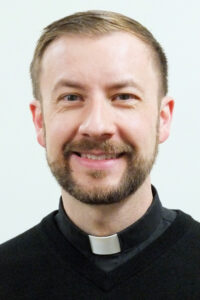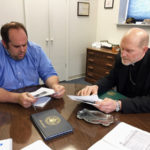By Fr. Thom Hennen
Question Box
Q: Can you explain the difference between the German or European model of selecting bishops and how it is done here in the United States?
A: As we continue to await the announcement of a new bishop for the Diocese of Davenport, this is an interesting question. I did not know much about this myself and so had to do a little homework.

First, I think it might be helpful for our readers to explain that the way bishops are selected today is not always how it has been. Like many practices in the Church, this process has evolved over time. Perhaps the most famous story of a precipitous rise to the episcopate is the story of Aurelius Ambrosius, otherwise known as St. Ambrose of Milan. He was the governor of the province of Liguria and Emilia, headquartered in Milan, and was apparently very well liked or at least seen as the right compromise candidate to bridge the bitter divide between the Arian Christians and the Nicene Christians.
As the story goes, a boy in the crowd shouted, “Ambrose for bishop!” This caught on. Though Ambrose was raised in a prominent Roman Christian family and certainly knew and accepted the faith, he was not yet baptized. It would not have been uncommon in that time to delay baptism until nearer the end of life, believing as we do that baptism forgives all sins. Not a bad plan, unless you get run over by a chariot.
At any rate, despite Ambrose’s attempts to avoid this nomination (even hiding out for a time at a friend’s house), he eventually accepted. He was baptized, ordained a priest and consecrated a bishop within the span of a week! Obviously, it “took.” In fact, it worked out very well, as Ambrose proved to be an exemplary bishop. He may be best known for his most famous convert: St. Augustine of Hippo. It is an interesting historical “what if” to think what might have happened if Ambrose had said “no” to his election.
The point of this story is that at different times and places in the Church’s history the local (diocesan) Church has been more involved in the selection process or even election of their bishops. Even when the local Church was more involved, the pope’s approval was nonetheless sought. A potential problem with more local control of this process is that it can quickly become more political than spiritual, with candidates vying for the office or influencing the process more out of a desire for control than a desire to serve.
As to the “German/European” way, from my reading, a diocesan “chapter” of clergy (not laity) discerns and submits the names of potential candidates. However, this is not across Europe but in only 13 of the 27 dioceses in Germany, three dioceses in Switzerland and one diocese in Austria. Here in the United States, as in most of the world, that list (called a “terna”) is compiled and submitted by the metropolitan bishop (in our case the Archbishop of Dubuque) in consultation with the other bishops of the province (Iowa).
This list is then sent to the Apostolic Nuncio and on to the Dicastery for Bishops, who vet the candidates and eventually submit a list of three candidates in order of preference to the Holy Father. In either the “American” or the “German” way, there is no guarantee that any of the candidates will be selected. The pope can choose one of the three or ask for a new list to be generated.
In the end, it is still up to the Holy Spirit and the pope!
(Father Thom Hennen serves as the pastor of Sacred Heart Cathedral in Davenport. Send questions to messenger@davenportdiocese.org)











